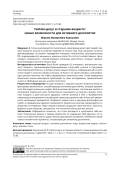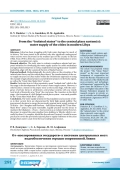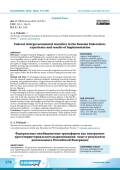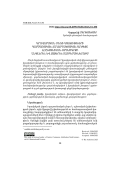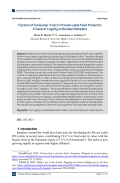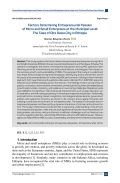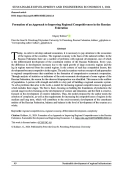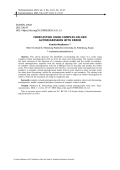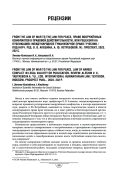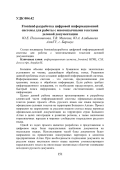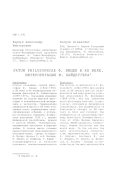Введение. В статье анализируется относительно новая форма досуга для людей старшего возраста: участие в качестве моделей на показах мод. Под старшими, согласно действовавшему на момент проведения интервью пенсионному законодательству РФ, подразумеваются женщины и мужчины после 55 и 60 лет соответственно.
Цель: показать возможности, способствующие активному долголетию, которые проявляются благодаря участию в показах мод. Методология и источники. Всего было проведено 32 интервью с москвичами старшего возраста, принимающими/принимавшими когда-либо участие в программе «Московское долголетие». У автора не было задачи получить информацию об их увлечении модой и участии в модных показах, не было и ни одного вопроса, затрагивающего данную тематику. Но ответы периодически возникали сами. Также проводился вторичный анализ имеющихся публикаций по теме исследования, сравнительный анализ и обобщение данных, анализ статистики. Результаты и обсуждение. В ходе интервью с людьми старшего возраста автор зафиксировал возможности, способствующие активному долголетию, которые проявляются благодаря увлечению модой. Многочасовые репетиции, постоянные занятия и тренировки модельного шага положительно сказываются на осанке и фигуре, помогают похудеть и даже улучшить здоровье. Снятие зажимов в теле и приобретение навыков фотопозирования способствуют новому восприятию себя и большей уверенности, мотивируют развиваться. Появляется новый стиль и красивые фотографии как память о проведенном времени; проявляются творческие качества и формируется сообщество по интересам. Люди старшего возраста ощущают свою важность, нужность, видимость для общества, признаются, что исполнили мечту детства, юности. Заключение. Информанты отмечали, что стали выглядеть и чувствовать себя моложе. Полученные навыки и первые результаты по ощущению себя другими, не такими, как в обычной жизни, задают вектор дальнейшего развития, появляются новые планы и жизненные горизонты, способствующие активному долголетию.
The paper presents an empirical study of the relationships between financial development, economic growth, urbanisation and energy consumption in the Southern African Development Community for the years 1980 to 2023. The researchers applied the Bayesian approach via Metropolis-Hasting and Gibbs samples as the MCMC methods, and Dumitrescu and Hurlin (2012) and Diagnostic tests to check the causality among all the variables in question and accuracy of the data and model. Over time, there has been a significant positive correlation between financial development, economic growth, industrialization, urbanization, and energy consumption. The results of the Granger causality test showed a unidirectional causal relationship between financial development, urbanization, and energy consumption supporting the alternative hypothesis that there is a relationship between financial development and energy consumption in the Southern African Development Community. It has been found that there is a Bi-directional (feedback) Granger causal relationship between economic growth and energy consumption in the Southern African Development Community; this also supports the alternative hypothesis. The results align with endogenous growth theory, which emphasizes that economic growth is driven by internal factors such as capital accumulation, innovation, and improved efficiencies, where energy plays a significant role. This also supports the view that energy infrastructure development is vital for sustaining economic growth in the region. The diagnostic tests confirm that the model is correct.
Relevance. Libya has been struggling with fresh water shortages for much of its history. This issue started to be resolved only after significant underground water reserves were discovered in the southern part of the country in the late 1960s. From 1970 to 2010, the country became one of the world leaders in terms of water consumption per capita. Research objective. The study aims to evaluate compliance adopted and proposed solutions for developing the water supply system for urban settlements and agricultural enterprises in Libya, implemented during Muammar Gaddafi’s leadership, align with the canonical theories of Spatial Science. Data and method. Methodologically, the study relies on the principles of the isolated state theory and the central place theory. The transformation of the water supply structure in Libya studies within the evolutionary approach on using the example of agricultural projects and settlement projects in the Kufra region, as well as the “Great Man-Made River” project. Results. Each state farm in Libya represents a quasi “isolated state” which is the first stage in the development of the country’s water supply system. However, it only becomes a system in the proper sense at the second stage, with the emergence of private farms in settlements: central place systems with one (rarely two) levels of hierarchy arise “from” the rural areas. The transition to the third stage-the formation of a full-fledged central place system-was made possible by the “Great Man-Made River” project. Conclusions. The water supply systems for the population and economy of Libya in their current form are characterized by fairly high spatial stability. The government’s decision to merge the previously separate water supply systems of Al-Kufra - Sirt / Benghazi and Hasouna - Sahl Jefara through the “Great Man-Made River” project was quite reasonable. Equally prudent was the choice to maintain the Ghadames - Zwara - Zawia system as an isolated entity. However, the project to extend the water pipeline from Ajdabiya to Tobruk, which is currently less than 1% complete, should be discontinued. Instead, it would be more practical to revisit the previously rejected plan to supply freshwater to the cities along Libya’s eastern coast from the local underground sources.
Relevance. Intergovernmental budgetary regulation is pivotal for promoting territorial equalization and bridging socio-economic gaps among regions. It ensures equitable access to public goods for all citizens, irrespective of their location. The effective distribution of federal financial assistance, guided by the principles of budget federalism, is essential for maintaining macroeconomic stability and fostering sustainable socio-economic development on the national and regional levels. Research Objective. The study aims to assess the competitive positions of Russian regions within the distribution system of federal intergovernmental transfers. Method and Data. To investigate Russia’s system of intergovernmental transfers, the research employs statistical methods, including structural-dynamic, grouping, and graphical analysis, along with novel analytical tools like the dependence coefficient and income coefficient. The study encompasses data from 2015 to 2022, sourced from the Federal Treasury and Federal State Statistics Service (Rosstat). Results. The study analyzes the dynamics of transfers from the federal budget to regional budgets and shows significant transformations in the transfer structure, revealing a decrease in non-targeted transfers and an increase in targeted ones. The study also examines the differences between regions in the distribution of these transfers. Russian regions were grouped depending on the share of federal transfers in their total budget income and the average per capita income in their consolidated budget. The study introduces a novel methodological approach through the use of newly developed tools - the dependence coefficient and income coefficient - to evaluate regional competitiveness. Conclusion. Despite an overall increase in federal transfers, persistent regional disparities intensify competition for financial assistance. These findings can be of interest to policymakers at federal and regional levels, researchers, and educators in relevant fields.
The article examines the use of passive voice and passive structures in the legal context, and particularly its use in the English and Armenian versions of the RA Family Code. Based on qualitative and quantitative, as well as case study methodology, the purposeful use of passive structures, their tendency to ensure maximum accuracy, as well as their functional-communicative features and the functions performed by them in legal speech are revealed in the study. The research also states that the frequency of applicability of the passive voice is due to the emphasis on the role of the action and not on the doer in both English and Armenian versions of the mentioned document belonging to legal discourse.
Retailers around the world have been actively developing the Private Label (PL) niche in recent years, significantly contributing to food sales in value. Therefore, the goal of this research is to determine the factors influencing trust in private label food brands among consumers in relation to loyalty to retailers. Hypotheses were formulated to identify the above-mentioned influence. The research involved an empirical approach combining qualitative (semi-structured interviews) and quantitative methods: Exploratory Factor Analysis (EFA); Confirmatory Factor Analysis (CFA) and Structural Equation Modelling (SEM). The online survey was conducted in March-April 2023 (387 respondents). The criteria for selecting respondents were that they resided in Moscow or the Moscow region; were aged 18 years or older; at least once bought private label branded food in the previous year. Analysis revealed the most significant factors of trust development in private label brands foods among consumers. They were structured and systematised, and recommendations were also formed for Russian retailers to strengthen consumer loyalty in the “dairy” category. The study addresses a gap in theoretical publications regarding the influence of factors on the choice of private label branded food products on loyalty to the retailer. The results can be used to analyse the factors of choice, their structure and influence on loyalty to private label branded foods in other product categories, as well as for the study of such influence and adaptation of the results obtained in other regions of Russia, due to a different socio-demographic profile of the population. The results can be adapted for different price segments of private label branded foods.
This study explores the factors determining entrepreneurial passion among Micro and Small Enterprises (MSEs) in the service and industrial sectors of Dire Dawa, Ethiopia. The research investigates the extent of entrepreneurial passion among MSE operators, identifies key personal, environmental, and institutional factors, and analyzes their impact on the success, growth, and sustainability of MSEs. The purpose of the study is to understand how these factors shape entrepreneurial passion, identify key drivers and barriers and offer practical recommendations for enhancing MSE performance. Utilizing a mixed-methods approach, both quantitative and qualitative data were collected from 248 MSE operators selected via stratified sampling across five sectors. The findings reveal a strong sense of passion, motivation, and emotional commitment, primarily driven by financial independence, growth opportunities, creativity, and resilience in overcoming challenges. Regression analysis highlights the significant role of personal characteristics such as age, education, prior experience, and risk-taking propensity in fostering entrepreneurial passion. Additionally, external factors, including market competition, technological advancements, government policies, and supportive networks, are shown to be critical in encouraging innovation and creating a conducive environment for entrepreneurship. The research concludes that entrepreneurial passion is influenced by a dynamic interaction of intrinsic and extrinsic factors. The study’s theoretical contribution lies in advancing understanding of the drivers of entrepreneurial passion, while the practical significance includes recommendations for policymakers, educators, and practitioners to address challenges such as financial constraints, regulatory barriers, networking difficulties, and work-life balance issues. These insights can help enhance MSE success, sustainability, and long-term entrepreneurial passion.
Today, in order to develop national economies, it is necessary to pay attention to the economies of the regions of the countries. The regional economy is the basis of the national welfare. In the Russian Federation there are a number of problems with regional development, one of which is the differentiated development of the constituent entities of the Russian Federation. Every year, the difference in development increases due to the rapid growth of large economic regions and the lag in regions removed from the central regions. In the context of such key competition factors, this development becomes competitive in the region. The article examines various concepts of and approaches to regional competitiveness that contribute to the formation of comprehensive economic cooperation. Through analysis of statistics on indicators of the socio-economic development of some regions of the Russian Federation, the reason for the observed disproportion was identified. This reason is the outflow of population. A person with strength and skills is a key part of building a regional economic system. To solve problems that arise in the work, a model for increasing regional competitiveness is proposed, which includes three stages. The first is basic, focusing on building the foundations of production; the second stage involves focusing on the development of science and education; and the third is creative, focused on the development of creative industries. Thus, the model proposed by the author meets the criterion of complexity, as well as the requirements for increasing the competitiveness of regions in the medium and long term, which will contribute to the socio-economic development of the constituent entities of the Russian Federation, balance and balance in the level of development of the country as a whole.
This article discusses the possibility of predicting the values of a series using complex-valued autoregression with an error for short-term forecasting. The authors consider the basic concepts of the function of a complex-valued variable and the model of complexvalued autoregression, together with the results of applying first- and second-order models of complex-valued autoregression with the CARE(p) error to describe and predict the initial series. The results obtained are compared with the first- and second-order autoregression in real numbers. A complex-valued autoregression model with an error showed a more accurate result for short-term forecasting, unlike the autoregression model in real numbers. The authors also conclude that complex-valued autoregression with an error is subject to further investigation in order to find out the prospects of using its imaginary part.
Статья-рецензия на публикацию: Международное гуманитарное право: учебник / под науч. ред. В. В. Алешина, А. Ю. Ястребовой.
Целью настоящего учебника является получение и закрепление знаний слушателями по теории международного гуманитарного права (МГП), а также их использование в правоприменительной деятельности и межгосударственных отношениях. Авторы приложили значительные усилия к тому, чтобы представить изучение МГП в расширенном контексте и выйти за рамки ограниченного понимания его предмета как совокупности правоотношений воюющих сторон.
Статья посвящена frontend-разработке цифровой информационной системы для работы с многоязычными текстами деловой документации.
Статья посвящена судьбе философии Ф. Ницше (1844-1900) в ХХ веке и ее интерпретации немецким философом М. Хайдеггером (1889-1976), оказавшим решающее влияние на судьбу мировой философии и континентальной метафизики в частности. Герменевтика ницшеанской мысли в ХХ веке есть прежде всего герменевтика катастрофических событий, с которыми столкнулась Германия: Ноябрьская революция 1918 г., кризис Веймарской республики, приход к власти NSDAP, технократия, «размывание человека» и мировые войны. В статье мысль главных представителей революционного консерватизма, среди которых: А. Молер, братья Э. и Ф. Юнгеры, К. Лёвит, А. Боймлер, Г. Фишер - позиционируется в качестве основного «экзистенциального» основания интерпретации М. Хайдеггера. Отличительными чертами хайдеггеровской методологии указываются заимствование у А. Молера понятия «принятия всерьез» и диалектика Бытия - сущего. Взгляд М. Хайдеггера на мысль «философа без гражданства» сосредотачивается вокруг трех главных фокусов: критики ценностей, Wille zu Macht и идеи «Ewige Wiederkunft». Особое внимание уделяется пониманию Хайдеггером концепции «смерти Бога», которая в его толковании не имеет ярко выраженного антихристианского характера. Невозможность окончательно преодолеть ценностную парадигму, направляемую основным инстинктом воли к власти, определяется в качестве основного изъяна философии Ф. Ницше, скрывающего Бытие и истинный характер сущего и не способного окончательно преодолеть метафизику.
